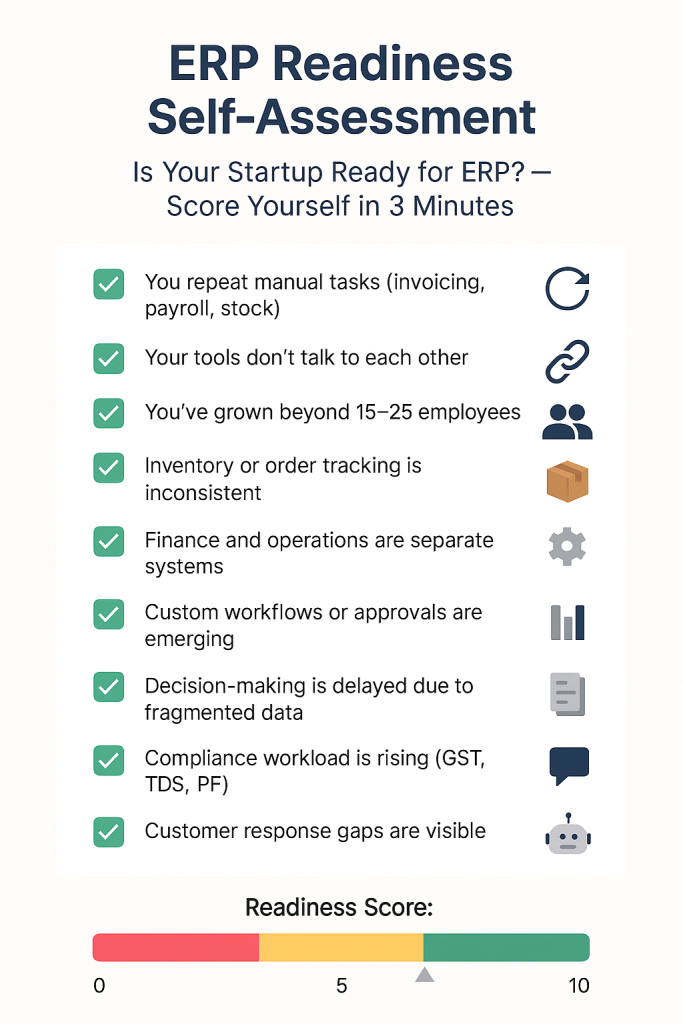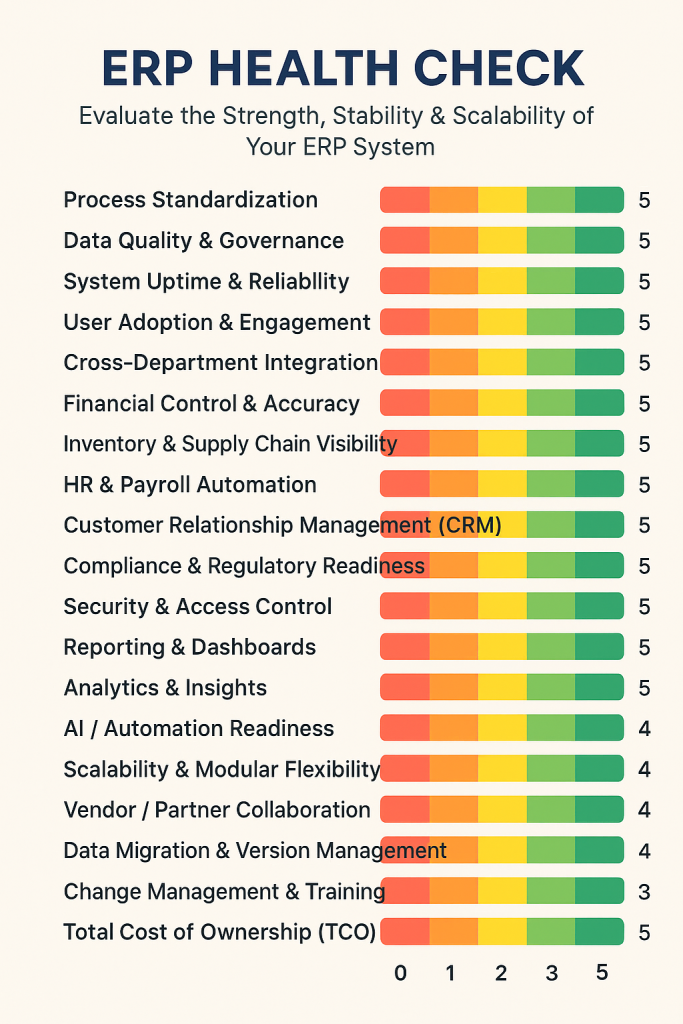
📈 Readiness Scoring Guide
🟢 8–10 points:
✅ You’re Ready.
Your startup has outgrown basic tools. Begin evaluating ERPNext, Odoo, or Zoho ERP with a phased rollout (Finance → HR → CRM).
🟡 5–7 points:
⚙️ Emerging Readiness.
You’re approaching ERP maturity. Standardize workflows, pilot one ERP module, and review integration feasibility.
🔴 0–4 points:
🧩 Not Yet Ready.
Focus on defining and stabilizing internal processes first. Use lightweight tools (CRM, invoicing) until operations repeat consistently.
 When Is the Right Time for a Startup to Implement ERP?
When Is the Right Time for a Startup to Implement ERP?
A startup should consider implementing an ERP system once it achieves operational stability and functional repeatability — typically when processes begin to outgrow spreadsheets, ad-hoc tools, or siloed software.
Detailed Perspective:
 Early Stage (0–1 Year): Focus on Agility, Not ERP Yet
Early Stage (0–1 Year): Focus on Agility, Not ERP Yet
At this point, the startup is validating its product, business model, and customer base.
Priorities: market fit, revenue model, team structure.
Tools: spreadsheets, low-cost CRM, accounting apps (e.g., Zoho Books, QuickBooks).
ERP?
Too early. Implementation may slow agility and add unnecessary cost.

 Growth Stage (1–3 Years): The Right Window for ERP
Growth Stage (1–3 Years): The Right Window for ERP
This is when structured processes start forming, and scalability becomes the goal.
Business activities are recurring and cross-functional.
Data duplication or version conflicts appear.
Decision-making slows due to lack of unified visibility.

When the startup has:
More than 15–25 employees,
Multiple departments (sales, finance, HR, inventory, etc.),
Recurring transactions across systems,
A clear growth roadmap (scaling, funding, or expansion).
Recommended ERP Type:
Cloud-based or Open-source ERP (ERPNext, Odoo, or Zoho ERP) — cost-effective, flexible, and modular.
Start small: deploy key modules (Finance + CRM + HR), then expand.
 Expansion Stage (3+ Years): Scaling Demands Integration
Expansion Stage (3+ Years): Scaling Demands Integration
At this point, disconnected tools create data friction. You need automation and compliance visibility.
Signs: multiple branches, tax compliance complexity, inventory management issues.
ROI justifies ERP investment due to higher transaction volume.
Recommended ERP Type:
Mid-tier ERP (Odoo Enterprise, NetSuite, SAP Business One, or ERPNext Cloud).
Focus on scalability, analytics, and India-specific compliance (GST, TDS, etc.).
 Rule of Thumb
Rule of Thumb
“Implement ERP when managing your business operations becomes a task in itself.”
If you’re spending more time managing tools than managing growth, it’s the right time for ERP.
 Optional Pre-ERP Step
Optional Pre-ERP Step
Before adopting ERP, startups can use a “Process Maturity Audit” — a 2-week internal review that assesses:
Repetition of manual processes
Cross-department dependencies
Compliance readiness
Data consistency
This helps determine readiness and select the right ERP tier.
Summary Table:
| Stage | Typical Age | ERP Need | Focus Area | Recommended Type |
|---|---|---|---|---|
| Idea / Early | 0–1 yr | Low | Agility, Product Fit | Basic accounting & CRM |
| Growth | 1–3 yrs | High | Structure & Visibility | Cloud ERP (ERPNext, Odoo, Zoho) |
| Expansion | 3+ yrs | Critical | Automation, Compliance, Analytics | Full-scale ERP (SAP B1, NetSuite, D365) |
✅ Startup ERP Readiness Checklist
“10 Signs Your Startup Is Ready to Move from Tools to Systems.”
ERP adoption is not a question of if, but when.
This checklist helps founders and operations leaders assess whether their startup has reached the stage where ERP will add measurable value rather than slow down agility.
🧩 1️⃣ Repetitive Manual Processes
You perform the same tasks (invoicing, payroll, stock tracking) every week or month using spreadsheets or multiple apps.
🔹 Indicator: Rising duplication and version errors in routine operations.
📊 2️⃣ Disconnected Systems
Accounting, CRM, inventory, and HR tools do not talk to each other.
🔹 Indicator: Frequent re-entry of data across systems; difficulty tracking end-to-end performance.
👥 3️⃣ Team Expansion
You’ve grown beyond 15–25 employees, and multiple teams now handle different workflows.
🔹 Indicator: Departmental silos, miscommunication, and lack of visibility across teams.
📦 4️⃣ Inventory or Order Tracking Issues
Stock levels, deliveries, or project timelines are not visible in real-time.
🔹 Indicator: Over/under-stocking or delayed service commitments.
💸 5️⃣ Financial Data Fragmentation
Finance and operations data are managed separately, making monthly closure and audits tedious.
🔹 Indicator: Delays in reconciling accounts, TDS/GST mismatches, or lack of unified dashboards.
⚙️ 6️⃣ Custom Workflows Are Emerging
You’ve begun creating custom workflows, approvals, or role hierarchies for daily operations.
🔹 Indicator: Your startup is building internal process logic — a sign you need an ERP backbone.
📈 7️⃣ Decision-Making Feels Slow
Founders and managers lack unified, real-time insights into sales, expenses, or team productivity.
🔹 Indicator: You rely on end-of-month reports instead of real-time dashboards.
📑 8️⃣ Compliance Complexity Increasing
You must regularly file GST, TDS, PF/ESI, or generate statutory reports.
🔹 Indicator: Manual compliance tracking creates risk of delays or errors.
💬 9️⃣ Customer Experience Gaps
Orders, deliveries, or support tickets are managed across multiple channels with inconsistent communication.
🔹 Indicator: Drop in response time or repeated client follow-ups.
🤖 🔟 Desire for Automation & Scale
You’re ready to automate workflows and use data intelligently for growth.
🔹 Indicator: Need for analytics, role-based dashboards, or predictive insights.
📘 Readiness Summary
| Level | Description | ERP Recommendation |
|---|---|---|
| Basic | 3 or fewer signs | Not ready yet – focus on process standardization. |
| Emerging | 4–6 signs | Evaluate light-weight ERP or pilot implementation. |
| Ready | 7–10 signs | Begin phased ERP rollout with clear roadmap. |
🌱 Strategic Insight
“When operations start creating friction, ERP turns friction into flow.”
Adopting ERP at the right stage saves rework, builds data discipline, and accelerates scaling. For startups in their growth phase (1–3 years), a modular cloud ERP like ERPNext, Odoo, or Zoho provides flexibility without heavy investment — allowing you to grow feature by feature as maturity increases.

 ERP Health Check Scorecard — 20 Dimensions
ERP Health Check Scorecard — 20 Dimensions
Comprehensive Evaluation of ERP Readiness, Performance & Intelligence
Comprehensive diagnostic model that evaluates every critical aspect of ERP maturity.Below is a professionally structured “ERP Health Check Scorecard — 20 Dimensions” document with:
20 scoring dimensions (each rated 0–1–2–3–4–5 → total 0–100 or scaled to 0–20)
Opening statement to introduce the framework
Closing guidance on interpretation, maturity levels, and follow-up action
 Opening Statement
Opening Statement
A robust ERP system is the backbone of digital business performance — integrating processes, people, and insights.
The ERP Health Check Scorecard (20 Dimensions) helps organizations objectively evaluate the strength, stability, and scalability of their ERP ecosystem.
Each dimension is rated on a 0–5 scale, where 0 indicates non-existent or broken capability, and 5 represents optimized, automated, and data-driven performance.
This structured evaluation enables leadership teams to identify gaps, plan improvements, and align ERP capabilities with strategic growth.
 ERP Health Dimensions (20 Total)
ERP Health Dimensions (20 Total)
| # | Dimension | Focus Area / What It Measures | Score (0–5) |
|---|---|---|---|
 Process Standardization Process Standardization | Existence of clearly documented and repeatable workflows across departments. | ☐ | |
 Data Quality & Governance Data Quality & Governance | Accuracy, consistency, and completeness of master and transactional data. | ☐ | |
 System Uptime & Reliability System Uptime & Reliability | ERP availability and technical stability (downtime, speed, errors). | ☐ | |
 User Adoption & Engagement User Adoption & Engagement | Percentage of active users, ease of use, and user satisfaction. | ☐ | |
 Cross-Department Integration Cross-Department Integration | Seamless flow of data between finance, HR, operations, CRM, etc. | ☐ | |
 Financial Control & Accuracy Financial Control & Accuracy | Strength of financial reporting, compliance with GST/TDS, and audit readiness. | ☐ | |
 Inventory & Supply Chain Visibility Inventory & Supply Chain Visibility | Real-time inventory tracking, demand forecasting, and vendor performance. | ☐ | |
 HR & Payroll Automation HR & Payroll Automation | Accuracy of payroll, employee data integration, and statutory compliance. | ☐ | |
 Customer Relationship Management (CRM) Customer Relationship Management (CRM) | Lead tracking, order management, and customer service response integration. | ☐ | |
 Compliance & Regulatory Readiness Compliance & Regulatory Readiness | Adherence to local tax, labor, and data protection laws (India + global). | ☐ | |
1 Security & Access Control Security & Access Control | Role-based access, audit trails, and cybersecurity protocols. | ☐ | |
1 Reporting & Dashboards Reporting & Dashboards | Availability of real-time reports and decision dashboards. | ☐ | |
1 Analytics & Insights Analytics & Insights | Predictive, prescriptive, and trend-based analytics maturity. | ☐ | |
1 AI / Automation Readiness AI / Automation Readiness | Level of workflow automation, machine learning, or RPA integration. | ☐ | |
1 Scalability & Modular Flexibility Scalability & Modular Flexibility | Ability to add new users, modules, or branches without system strain. | ☐ | |
1 Vendor / Partner Collaboration Vendor / Partner Collaboration | Supplier and partner integration through portals or APIs. | ☐ | |
1 Data Migration & Version Management Data Migration & Version Management | Ease and accuracy of migration, updates, or ERP upgrades. | ☐ | |
1 Change Management & Training Change Management & Training | Effectiveness of user onboarding, feedback loops, and continuous improvement. | ☐ | |
1 Total Cost of Ownership (TCO) Total Cost of Ownership (TCO) | Balance between ERP cost, value delivered, and ROI sustainability. | ☐ | |
2 Strategic Alignment Strategic Alignment | ERP’s alignment with business goals, KPIs, and long-term growth vision. | ☐ |
 Scoring Guidance (0–5 Scale per Dimension)
Scoring Guidance (0–5 Scale per Dimension)
| Score | Interpretation | Meaning |
|---|---|---|
| 0–1 |  Critical Critical | Capability absent or non-functional; immediate intervention needed. |
| 2 |  Weak Weak | Exists but inconsistently used; high manual dependency. |
| 3 |  Moderate Moderate | Functional but limited automation or reporting. |
| 4 |  Strong Strong | Stable, standardized, and measurable process. |
| 5 |   Optimized Optimized | Fully integrated, automated, and continuously improving. |
 Total ERP Health Score Interpretation
Total ERP Health Score Interpretation
| Total (out of 100) | ERP Health Level | Interpretation & Action |
|---|---|---|
| 85–100 |  Future-Ready ERP Future-Ready ERP | Fully mature, analytics-enabled, and strategically aligned. Maintain continuous AI integration and innovation. |
| 65–84 |  Operationally Strong Operationally Strong | Core functions optimized; focus on analytics, automation, and user engagement. |
| 45–64 |  Developing ERP System Developing ERP System | Foundational processes exist but lack integration or real-time intelligence. Prioritize standardization and data cleansing. |
| 25–44 |  Underperforming ERP Underperforming ERP | High manual workload and poor adoption; requires structured process re-engineering. |
| 0–24 |  ERP Breakdown / Not Implemented ERP Breakdown / Not Implemented | Minimal or no ERP capability; begin readiness and process alignment before system selection. |
 Closing Notes & Guidance
Closing Notes & Guidance
A successful ERP ecosystem is measured not by implementation alone, but by how deeply it integrates into your business DNA — unifying information, guiding decisions, and enabling agility.
Next Steps After Scoring:
- Identify Weak Dimensions (Score ≤ 3):
Conduct targeted reviews or workshops for each low-scoring area. - Prioritize Improvements:
Focus on data quality, process integration, and user adoption before advanced automation. - Schedule Quarterly Health Checks:
ERP health is dynamic — repeat this assessment every 3–6 months. - Align with Business Strategy:
Map ERP goals to revenue, customer, and compliance objectives. - Engage Stakeholders:
Involve finance, HR, operations, and IT teams in each review cycle.
 Leadership Insight
Leadership Insight
“Healthy ERPs don’t just automate — they anticipate.
The stronger the system health, the faster the enterprise adapts.”
